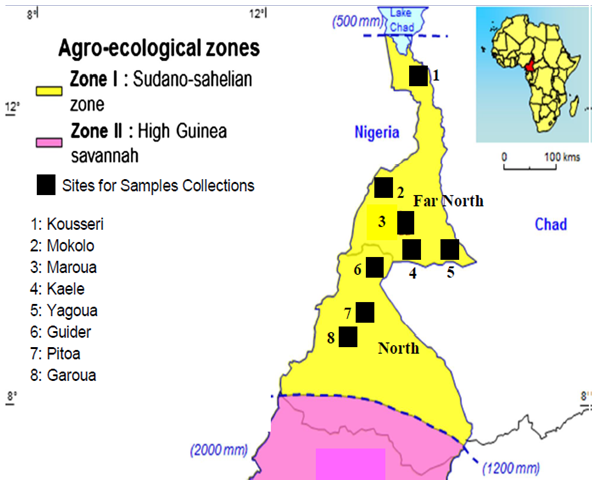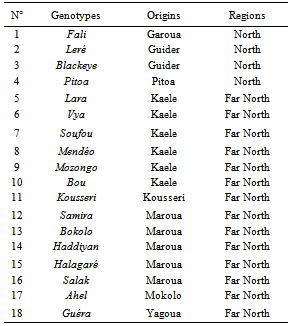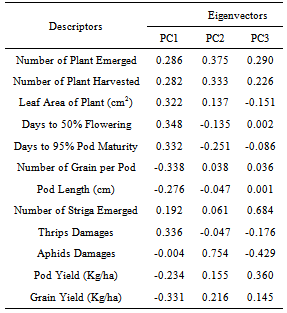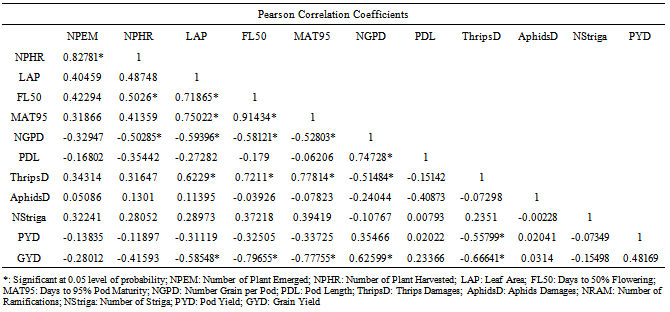-
Paper Information
- Next Paper
- Previous Paper
- Paper Submission
-
Journal Information
- About This Journal
- Editorial Board
- Current Issue
- Archive
- Author Guidelines
- Contact Us
International Journal of Agriculture and Forestry
p-ISSN: 2165-882X e-ISSN: 2165-8846
2013; 3(4): 170-177
doi:10.5923/j.ijaf.20130304.08
Characterization of Some Traditional Cowpea Varieties Grown by Farmers in the Soudano-Sahelian Zone of Cameroon
Sobda Gonné1, Wirnkar Lendzemo Venasius1, Amadou Laminou2
1Department of Annual Crops, Institute of Agricultural Research for Development, Maroua, P. o. Box 33, Cameroon
2Department of Life and Earth Science, University of Maroua, Maroua, P. o. Box 55, Cameroon
Correspondence to: Sobda Gonné, Department of Annual Crops, Institute of Agricultural Research for Development, Maroua, P. o. Box 33, Cameroon.
| Email: |  |
Copyright © 2012 Scientific & Academic Publishing. All Rights Reserved.
Cowpea (Vigna unguiculata L. Walp.) is a legume crop grown in the semi-arid regions of Africa. Some farmer’s local varieties possess stable traits that could be selected for breeding, but there is lack of information. Eighteen cowpea genotypes from farmer’s field were planted in a randomized complete block design with four replications at the experimental farm of the Regional Agricultural Research Centre of Maroua in 2011 for agro-morphological characterization. The data collected were subjected to multivariate analysis using XLSAT2013 and correlations were performed on SAS (Statistical Analysis System) version 9.3. The results revealed that the genotypes were predominantly spreading habit with rough and white seeds. Despite the variability of the genotypes, the results also indicated that they form five distinctive groups in the base of discriminant descriptors. Regarding the interrelationship between the descriptors, the leaf area (r = -0.58), days to 50% (r = -0.79), days to 95% maturity (r = -0.77) and thrips damages (r = -0.66) showed a significant negative correlation to the grain yield indicating the need for advising early cowpea maturing varieties where the rainfall cycle is short. In addition, late maturing genotypes are more subject to thrips damages. A significant positive correlation was revealed between the number of the grain per pod and the grain yield (r = 0.62), suggesting that this descriptor is the most important yield component for cowpea. Molecular investigation could provide additional information on the genetic basis of these genotypes.
Keywords: Genotypes, Agro-morphology, Assessment, Descriptors
Cite this paper: Sobda Gonné, Wirnkar Lendzemo Venasius, Amadou Laminou, Characterization of Some Traditional Cowpea Varieties Grown by Farmers in the Soudano-Sahelian Zone of Cameroon, International Journal of Agriculture and Forestry, Vol. 3 No. 4, 2013, pp. 170-177. doi: 10.5923/j.ijaf.20130304.08.
Article Outline
1. Introduction
- Cowpea (Vigna unguiculata Walp) is one of the most legumes widely grown and consumed in the tropical region of Africa ([1],[2]). The dry Savannah regions of the West and Central Africa are the privileged geographic area of cowpea production where more than 80% of farmers are involved in the cultivation[3]. Cowpea production ofCameroon is annually estimated at 152 000 tones[4] where more than 80% of it is from the soudano-sahelian region of the northern part of the country[5]. Along with cereals such as sorghum and maize, this crop constitutes the main diet for the local population[6]. Its grain and leaves are rich sources of high-quality protein[7], which provides an excellent supplement to the lower quality cereal or root and tuber protein consumed in much of this region ([8],[9]). Moreover to its role as food, cowpea has become a commercial crop for poor farmers and its fodders are very important for animal feeding[7]. However, cowpea yield is limited by several constraints, some are biotic such as insects, diseases and pest weeds peculiarly Striga gesneroides while others are abiotic as erratic rainfall, soil salinity and heat. At the farmer’s level, different varieties with a broad geneticbackground are being grown. Many of them possess interesting traits for which genes could be exploited by breeders to integrate in cowpea improvement program. Furthermore, they are well adapted to the local farming system and are able to produce stable yield[10] in the fragile agro -ecological zone of the North Cameroon. Unfortunately, until now few studies have been conducted to provide information on these local promising varieties despite its importance as a key factor for their selection[11]. Thus the objective of this study was to characterize and evaluate the agronomicperformance of some local cowpea varieties under the agro - climatic conditions of the North Cameroon. This would provide information that would serve for their selection according to the importance of the traits they may carry to assist the national cowpea breeding program.
2. Material and Methods
2.1. Experimental Site
- The experiment was conducted in 2011 at the experimental farm of the Regional Agricultural Research Centre of Maroua located at Guiring, 7 Km in the north of Maroua, the capital of the far north region of Cameroon. Guiring is located at 900 m altitude (10º 00’ to 12º 30’N; 13º 30’ to 15 30’E). The soil is mostly sandy-clay[12]. The climate is tropical soudano-sahelian characterized by two annual seasons: a short raining season from 4 months from June to September and 8 months of dry seasoncovering October to May. The cumulative annual rainfall is between 800 and 1,000 mm. The temperature varies around 35ºC with a maximum of 40ºC during the month of April[13].
2.2. Biological Material
- Thirty varieties were collected from seven most cultivated cowpea areas in the North and the Far North region corresponding to the Soudano-Sahelian zone of Cameroon. Based on the similarities observed in the form, color, size and texture of the grain, the number was reduced to eighteen genotypes as follow: Kousseri (01); Mokolo (01); Maroua (05); Kaele (06) and Yagoua (01) in the far north; and Guider (01); Pitoa (01) and Garoua (01) in the North region (Figure 1 and Table 1).
2.3. Experimental Design
- The experiment was conducted, during the raining season in a randomized complete blocks design (RCBD) with four replications where each experimental unit was consisted of a rectangular plot (2.4 m x 5.0 m) of 12 m2. Cowpea seeds were sow in four lines of 5 m per plot providing 0.20 m between hole in the same line and 0.80 m between lines. Two cowpea seed were sow per hole at a depth of 0.03 m to 0.04 m during the month of August. Plugging was carried out two weeks before planting. Weeding was performed manually when necessary. Delta-methrin was spray three times at the rate of 1l.ha-1 to control insects at the budding, flowering and podding stages.
|
2.4. Data Collection
- The following data were collected from the plants in the two middle rows of each plot. (i) In the filed level: counting of the number of plant emerged, number of plant harvested, days to 50% flowering, days to 95% maturity, leaf area, the stem colour and the growth habit. From natural field infestation, pest weeds and insects damages were assessed respectively by counting the number of striga per plot at 9 weeks after sowing (WAS) and the use of a visual scoring scale of 1.0 to 5.0 for aphids (Aphis craccivora) and thrips (Megalurothrips sjostedti) as applied in Jackai and singh[14]. Aphids damages included the curling of leaves, number of aphid colonies seen, presence of sooty mould and cast skins, growth retardation and dead plants. The scoring was done at 2, 4 and 6 weeds after sowing. 1.0 = (0%) resistant; 1.1-1.5 = (1-25%) moderately resistant; 1.6-3.5= (26-50%) moderately susceptible; 3.6- 5.0= (51-100%) very susceptible. Damages from thrips were scored at the critical developmental stages budding (35 DAS), at 50% flowering (55 DAS) and podding stage (70 DAS). Scoring included the brown discoloration and dryness of stipule, leaves or buds and the elongation of peduncles. Genotypes with scores of; 1.0 = (0%) resistant; 1.1-1.5 = (1-25%) moderately resistant; 1.6-3.5= (26-50%) moderately susceptible; 3.6-5.0= (51-100%) very susceptible. (ii) At the lab unit of Maroua research centre, 10 pods were randomly selected per plot and the lengths were measured using a ruler. Then the pods were hand threshed to remove the seeds. The seeds were counted from 10 pods and the mean per pod was determined. After that, seed colour and texture were determined visually. Finally pods and seeds were weighed for each individual plot and the obtained weight was used for yield calculation: Y= (W/PA)*10 000Y= Pod or Grain yield (Kg/ha)W = Pod or Grain weight (Kg)PA = Plot Area (m2)
2.5. Data Analysis
- Hierarchical cluster analysis of genotypes was made to the component principal component analysis usingXLSTAT2013 based on the means of the agro-physiological parameters and computation of Pearson Correlation was performed by Statistical Analysis System (SAS) version 9.3 to establish interrelationships among the descriptors.
3. Results
3.1. Morphologic Characters of the Cowpea Genotypes
- Based on their morphology divers cowpea genotypes have been observed among the farmers cultivated varieties. They can be easily grouped into 3 distinctive groups according to their growth habit: erect, semi-erect and spreading. Moreover, it has been observed that half of the cowpea varieties cultivated by farmers are spreading (50%). In addition it was observed that genotypes can be ranged into 3 groups depending on the color of their stem: light-green (50%), purple (33.3%) and green (16.6%). Nevertheless the genotypes tested didn’t appear to be different in term of seeds color and texture regardless of location of origin. They were overall white (94.4%) and rough (100%) with only one exception from the location of Kousseri where the variety collected (Kousseri) has shown red seeds (Table 2).
|
3.2. Evaluation of Agronomic and Physiological Traits
3.2.1. Grouping of Variables
|
|
3.2.2. Grouping and Characterization of Genotypes
- Based on the hierarchical cluster analysis and the cutting of the dendogram at 6.0% the results revealed that the eighteen cowpea genotypes formed five distinctive groups (Figure 2) displaying 34.39% dissimilarity within group and 65.65% between groups from optimal classification. Each of the group showed clear specifics traits for which the performances differed from those of the other groups (Table 5). Group 1 (G1) is constituted by Halagari, Samira, Ahel and Fali. These are mainly long cycle genotypes having days to 50% flowering around 75 days, days to 95% pod maturity was observed around 90 days. The genotypes of this group are also characterized by large leaves (16.28cm2), they were found as the most susceptible to thrips damages showing a score of 4.69 and lowest pod and grain yield (1521.86 kg/ha and 136.56 kg/ha).
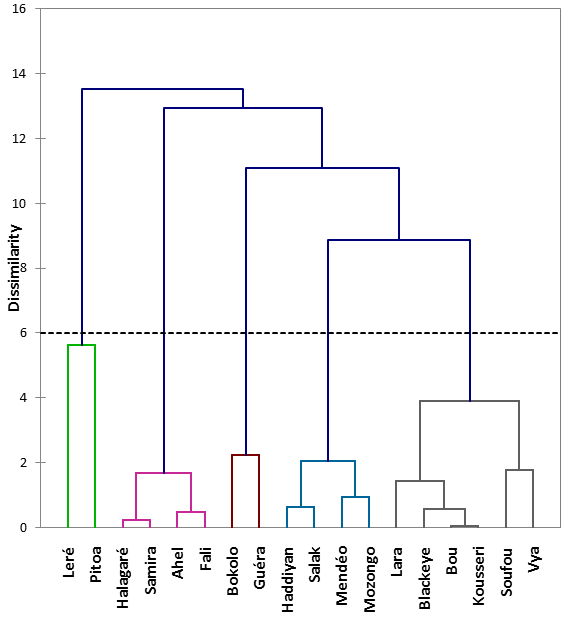 | Figure 2. Hierarchical clustering of genotypes based on the agro-physiological descriptors |
|
|
3.2.3. Analysis of Interrelationship among the Descriptors
- From the results obtained in table 6, it was observed that grain yield was significantly correlated to somephysiological parameters such the leaf area (r = -0.58), days to 50% flowering (r = -0.79), days to 95% pod maturity (r = -0.77) and to a yield component illustrated by the number of grain per pod. In the same way, additional correlations were found between the grain yield and both the pod length and the pod yield where coefficients of correlation were r = 0.23 and r = 0.48 respectively. Further observations of the same table has shown that strong negative correlation (r = -0.66) was found between the damages caused by Thrips on cowpea plants and the potential final grain yield. The same figure was noted also in the case of Striga gesneroides which affected negatively both the pod and the grain yield. It has been also noted that the effect of Thrips attack was significantly correlated to three physiological traits of the plant such as the leaf area (r = 0.62), the days to 50% flowering (r = 0.72) and 95% maturity (r = 0.77) indicating that the impact of this insect is more severe when the variety have long growth cycle. The latter two parameters were found to be correlated to the first one which is the leaf area with r = 0.71 and r = 0.75 respectively. In the other hand, positive correlation was observed between the pod length and the number of grain per plant.
4. Discussion
- According to the International Board for Plant Genetic Resources[15] descriptors, there are seven main growth habits in cowpea. From the study conducted on eighteen farmers local genotypes, three of these habits were identified. Most of them were spreading, other were semi-spreading type while the latter group with few genotypes have erect habit. These results are consistent with the findings of[16]. The small group number identified compared to the existing number of groups habit described by[15] could be explained by the fact that the sample size of this study is largely smaller than the one used by[15] which is made of various cowpea genotypes from the world. The stem colour of the cowpea collected was variables corroborating with the work conducted by[17]. It varies from green to purple and with a predominant colour of light green similar to the results obtained by[18]. With regard to seed, only two colours were found red and white with most of them being white. Although cowpea presents generally various seeds colour, only two of them where revealed in the case of the present study. This could means that farmers of the north Cameroon mostly preferred white and red cowpea. However, it should be noted that cowpea varieties with red are only grown in Kousseri specifically in the Lake Chad zone during the off season. The seed texture was globally rough deviating from the results of the experiment conducted by[19] where in addition, smooth cowpea seed group was mentioned. This could still depend on the preference of any farmer community. From the principal component analysis, PC1 associated with the leaf area of plant, days to 50% flowering, days to 95% pod maturity, number of grain per pod, pod length, thrips damages and grain yield accounted for 64.38% of the total variation. This mains that, the listed descriptors are the most effective characters for distinguishing among the eighteen traditional cowpea varieties sampled and PC1 is one of the most important features in the selection of these characters. Thus it could be a useful tool to help breeder for selection. However,[20] observed that onset of flowering in local cowpea may be ascribed to the photoperiod control which also depend on the latitude, the origin of the germplasm and the variation in day and night temperatures. In addition to PC1, PC2 and PC3 contributed for 10.84% and 8.44% respectively to the total variation of 83.66% reflecting large differences among the genotypes. Despite the diversity observed, the application of hierarchical clustering analysis based on the principal component analysed showed the eighteen genotypes form five discriminant groups. Each of the group has its peculiar characters that could be used for the description of the group. Group 1 (G1) was formed by late maturing varieties which have difficulty to complete their cycle properly because of the short length of the raining season in semi-arid zone of Cameroun where the rainfall is also erratic. They spent more energy in the vegetative growth such as development of large leaves in disadvantage of pod and grain production leading to low yield as observed in this study. The vegetative development is also in the benefit of pest insect such thrips which is one of the most economical damageable pests of cowpea. Except one genotype, all the varieties of the group are from the same region of the far north. Group 2 (G2) possess long pod length as an exclusive character, resulting in good pod and grain production. Pod length is one the most important yield components. Groups 3 (G3) and 4 (G4) are both constituted mainly with early maturing varieties. However the genotypes of G3 are susceptible to insects attack specially Aphids. Nevertheless it seemed to have less impact on the final yield as the result of the earliness of the genotypes to rapidly complete their cycle. Genotypes of G4 are higher yielding varieties resulting from the potential they have to produce large number of grains per pod and the shortness of their growth cycle. This is consistent with findings from which highlighted that good seed yields require varieties with short flowering periods to enable them divert energy into pod and seeddevelopment[21]. Furthermore it is stated that, the earlier a variety sets flowers, the earlier it matured[22]. In addition early maturity is recognised as a relatively important agronomiccharacteristic in plant breeding program[23]. Despite de good number per plant at the germination and harvesting period observed within the genotypes in groups, their grain yield was low. This could be explained mainly by their affinity to allow high rate germination Striga gesneriodes, which is a parasitic weed pest that takes nutrients directly from the plants. Base on the interrelationship among the descriptors, the number of plant emerged was highly correlated to the number of plant at harvesting meaning that the more vigour is the seed the more likely the resulted plant will complete its growth cycle withstanding both the abiotic and the biotic factors. As pointed earlier, early flowering genotypes are early maturing, this is illustrated by the higher coefficient of correlation (r = 0.91) similar to the findings of[17] who concluded that, days to flowering has an influence on days to maturity. However there were negative significant correlation among these descriptors and the grain yield. This confirms the statements of[24] and[25] that genotypes which flowered earlyproduced many pods and such genotypes maximize the favourable day length to initiate flowering and fruiting. Furthermore this observation suggests that the plants which take more time on vegetative stage have fewer yields in semi-arid conditions of production[26]. Also, Thrips damages were negatively and highly correlated to the grain yield logically implies that the more susceptible to thrips damages the less is the yield of the genotype. In the same way, genotypes with large leaves area put less energy in grain production revealed by the negative and significant coefficient of correlation (r = - 0.58).
5. Conclusions
- The characterization and assessment of the eighteen genotypes has provided phenotypic information on the farmer traditional cowpea varieties. The study revealed that the majority of the genotypes cultivated by farmers have spreading habit and they are predominantly white and rough seeds. Despite their various diversity and origin, they can be classified into five main groups based on some agro - physiological descriptors. The leaf area of plant, days to 50% flowering, days to 95% pod maturity, number of grain per pod, pod length thrips damages and grain yield are the most discriminant factors that could be used for the selection of these farmer’s traditional varieties. Further investigation establishing the molecular basis of these groups could provide useful information on these genotypes.
ACKNOWLEDGEMENTS
- The authors highly appreciated the support received from the Regional Agricultural Research Centre of Maroua without which the accomplishment of this study wouldn’t be effective.
 Abstract
Abstract Reference
Reference Full-Text PDF
Full-Text PDF Full-text HTML
Full-text HTML